The cosmic event happened about 3.9 billion light years from Earth in the direction of the Draco constellation.
A sleeping black hole woke up and devoured a passing star that drifted too close to it.
An artist's impression of the event shows the star being quickly sucked into the monster black hole, which then gives off a burst of X-rays.
It happened about 3.9 billion light years from Earth in the direction of the Draco constellation, and was spotted using high-energy X-ray data from NASA's public archives.
The black hole, with a mass a few million times larger than the sun, gorged on the star at a rate 100 times greater than a theoretical maximum known as the Eddington limit.
Nothing can escape a black hole after falling inside, including light.
The majority of supermassive black holes are dormant, meaning they are not actively consuming matter.
But occasionally a star drifts too close to a dormant black hole and a 'tidal disruption event' begins.
Authors of the new research say their findings could solve the mystery of how the largest black holes in the universe came to grow to such huge sizes.
The study's lead author Erin Kara, from the University of Maryland, said: "Most tidal disruption events don't emit much in the high-energy X-ray band.
"But there have been at least three known events that have, and this is the first and only such event that has been caught at its peak."
The event was first detected in 2011, but the extensive research into the event was concluded and published this week.







